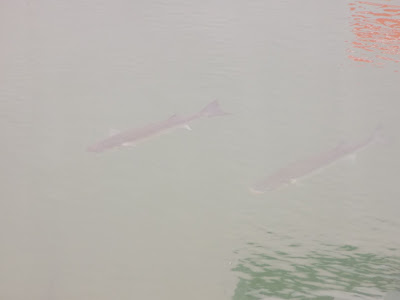I saw it again a few minutes later on my return journey where it kept hovering over the grass before diving down and catching a rodent. It then flew off with it's catch to a distant tree where I assume it ate it or possibly stored it for later.
It's likely that the catch was a vole as this is the most common prey that kestrels eat. They need to somewhere between four to eight voles every day(1) which is why they seem to always be hunting when you see them. As well as being able to hover on one spot they also have fantastic sight, being able to see and then catch a beetle from 50m away. Incredibly they are also ultraviolet sensitive which means they can follow the scent trails of rodents(2)!
It's very nearly November but locally red admirals seem to still be doing very well. On one ivy bush I found three individuals and there are plenty still on the wing.
In theory red admirals are butterflies which migrate to the UK from Europe but there is evidence that they are overwintering here in the South(3) and my personal experience would go along with that. Red admirals have one brood a year with the peak emergence being between mid-August and early-October(4). I am hypothesising that the emergence locally was towards the latter end of that period which would explain why there seem to be so many so late in the year. Of course the warmer temperatures mean they are thriving at the moment but this will only last for so long.
Walking along one of my favourite paths this week I was pleased to see large numbers of meadow pipits:
Meadow pipits are a relatively common bird in the UK thought numbers are declining. They can mostly be found in the uplands of the North of England and Scotland but they move south for the milder winter(5). Whilst they feed on invertebrates for most of the year, in winter they tend to eat seeds of grasses and heathers(6).
Up in some of the local trees are some sizeable mistletoe plants.
Mistletoe is mainly found in the South of the UK and the West Midlands and most commonly, but not always, on apple trees(7). Although we regard them as parasitic they are technically only 'hemi-parasatic'- this means that they have their own green leaves for photosynthesis and only rely on the host tree for water and mineral nutrients(8). Generally mistletoe doesn't do significant harm to it's host, damaging a few branches but not killing the tree.
Perhaps more common than mistletoe in our local trees at the moment are the grey squirrels.
At this time of year grey squirrels are gathering food to store for winter. They don't hibernate and instead build thicker dreys where they can hide up in very cold weather and then go out and find their stored food(9).
You don't tend to imagine squirrels to have calls but they seem to be very local at the moment. They have a variety of calls but I think I've been hearing their territorial 'barks', presumably a noise used to tell other squirrels and competing animals not to come near their food stores.
That's all for today and I shall see you in November.
_________________________________________________________________________________
2: Viitala, J; Korplmaki, E,; Palokangas, P and Koivula, M. (1995) 'Attraction of kestrels to vole scent marks visible in ultraviolet light' Nature 373 (6513) pp. 425-427 (Online here).
6: Hoya, J. (ed) (2004) Handbook of the Birds of the World, vol. 9. Barcelona: Lynx Edicions. pp.763.




































